Water with Integrated Local Delivery (WILD) for Transformative Change in Socio-Ecological Management (SITR6-9)
23.04.2021
SUBMITTING ORGANIZATION
Countryside and Community Research Institute
DATE OF SUBMISSION
23/04/2021
REGION
Europe
COUNTRY
UK
KEYWORDS
Integrated local delivery · Transformative change · Catchment scale · Socio-ecological · Landscape
AUTHOR(S)
Jasmine E. Black, Chris Short, and Jenny Phelps
J. E. Black · C. Short
Countryside and Community Research Institute, Cheltenham, Gloucestershire, UK
J. Phelps
Farming and Wildlife Advisory Group, Tetbury, Gloucestershire, UK
LINK
Abstract
An innovative approach towards transformative change through multi- stakeholder participation for socio-ecological practices—Integrated Local Delivery (ILD)—has been used to restore the water quality and biodiversity across a catchment in the Cotswolds, South West England. This was triggered by the need to improve the Ecological Status of water as a part of the European Union’s Water Framework Directive. On a landscape scale of roughly 25,000 hectares, multi- stakeholders collaborated through a bottom-up approach to carry out environmental restoration of the catchment.
Over 3 years, an iterative learning loop of reflection and evolution created increased engagement. Twenty farmers have been empowered as ‘guardians’ to be key contacts between institutions and ensure the sustained environmental quality of the area. Both farmers and communities acted to reduce chemical use, protect river banks from livestock damage and clear waterways to enhance water quality and biodiversity. Local communities fed into the development of a ‘Community Water Guide’ which can be applied internationally for similar projects. Within the Inter- governmental Science-Policy Platform on Biodiversity and Ecosystem Services (IPBES) transformative change framework, the ILD model can also be applied by facilitators to access levers and leverage points in order to enable change.
Important take home messages from the project include having well-trained facilitators who ensure active engagement, connections and continuity over the long term. Likewise, ensuring all stakeholders feel listened to and clearly communicated with is essential to build trust and motivation.
1 Introduction
Since the Rio Earth Summit in 1992, there has been a sequence of calls towards more sustainable management of the planet’s resources. This has included the Millennium Ecosystem Assessment in 2005 highlighting the depletion of resources by human activity, the work of the Intergovernmental Panel on Climate Change (IPCC), namely reports on the effects of 1.5 oC warming, and the recent 2019 Intergovernmental Science-Policy Platform on Biodiversity and Ecosystem Services (IPBES) Global Assessment Report on the need for transformational change (MEA 2005; de Coninck et al. 2018; IPBES 2019). Action has been encouraged at global and national levels to enact frameworks, such as the Convention on Biological Diversity (CBD) and IPBES’ transformational change framework (Tengö et al. 2017; Kozar et al. 2019). With the next IPBES assessment from 2021 onwards, a key question is why has transformative change not yet happened despite these frameworks being put in place.
Transformative change is a challenging concept for the top-down institutional and governance models of recent times; to be effective, it requires working across disciplines and institutional levels as well as the wider landscape. Inherently this is more complex than a single resource and a single discipline and institutional level undertaking management, therefore a ‘collective framing’ and an ‘integrated approach’ is needed (Thiel et al. 2015; Gualini 2018; IPBES 2019). Governance therefore also needs to be adaptive, allowing for communities to take ownership of actions on the ground, opposing top-down governance (Short 2015). Through this process, institutions learn that local communities are able to undertake effective resource management alongside other actors, which then influences these institutions and policies (Carlsson and Berkes 2005; Ostrom 2005). Importantly, social capital, trust, shared values and legitimacy are needed at local scales in order to make action effective (McAreavey 2006). Across disciplinary and institutional scales, these assets are also needed for good integration, collaboration and adaptation for landscape-scale resource management (Blackstock et al. 2014). Through working effectively together in this way, the range of societies and ecologies in a landscape, as well as the associated knowledge and governance mechanisms, can be transparently addressed to work out trade-offs in tangible and non-tangible benefits (IPBES 2019). This is an iterative learning loop, in which reflective practice and adaptation strengthen and progress socio-ecological systems (Alexander 2006; IPBES 2019).
The project assessed in this chapter used the Integrated Local Delivery (ILD) model, driven by the European Union’s (EU) Water Framework Directive (WFD), that called for all water courses to have ‘Good Ecological Status’ (GES) within a certain timeframe, which for the UK had been set at 2027. The WFD also encourages EU member states to take an approach which incorporates all stakeholder levels, from communities to policy as well as all process levels, from planning to implementation (Healey 1998). These inclusive co-developed methods of working holistically are progressing on national-global levels (Short 2015; Thiel et al. 2015). The ILD model method spans disciplines, institutional levels and landscape scales. It also allows for a critical assessment of its effectiveness, through ‘action research’. ILD has been applied to a range of projects and is easily transferrable to any community. Here we set out the ILD approach and show its effectiveness within the Water with Integrated Local Delivery (WILD) project. We also assess how the project utilises levers and leverage points across a diversity of stakeholders and ecological systems according to the IPBES framework (IPBES 2019).
2 The WILD Project
The WILD project was initiated in South West England within the Upper Thames river catchment area through a partnership between the Farming and Wildlife Advisory Group South West (FWAG SW), the Gloucestershire Rural Community Council (GRCC), the Cotswold Water Park Trust and the Countryside and Community Research Institute (CCRI), which is part of the University of Gloucestershire. The project ran through two stages, initially from 2013–2016 and then from 2016–2018. The project facilitator (FWAG) carried the framework over from a previous project to WILD. The facilitator involved has existing links with farming communities in the area and a history of working with them towards more environ- mentally sustainable practices. As a number of waterbodies in the case study area had been assessed as either moderate, poor or bad by the Environment Agency (EA) of the UK government, under the EU’s WFD, the project’s main objective was to improve the conditions and bring them to GES through an integrated approach. Its aims were:
- To deliver GES through ILD and direct actions, informed by catchment recon- naissance trips and advisory visits, in waterbodies in the WILD project area in line with the Upper Thames Catchment Management
- To create a framework to address other negative drivers impacting on water quality in the medium (2021) and long term (2027) to achieve GES in all surface and ground waterbodies as of EU
- To embed and enable local delivery so that the protection of water quality becomes self-sustaining, through awareness and collective responsibility of the
- To integrate and deliver the relevant objectives of partners using ILD.
- To assess the project’s effectiveness to inform future funding programmes and decision making of the multi-stakeholders
The case study site covers a diverse landscape of small urban settlements and rural areas of agricultural land, meadows, woodland, wetlands and waterbodies. This diversity has necessitated the incorporation of multiple stakeholders spanning a wide range of institutional and structural levels. It has therefore also been vital for these stakeholders to develop strong relationships, empathy and understanding of values and goals.
2.1 Case Study Site
The WILD project site covers about 26,000 ha within the river basin catchment area of the River Thames (Fig. 9.1). It lies within the Cotswolds and Upper Thames Clay Vales ‘Natural Character Area’, designated to highlight similar national characteristics for landscape-scale management (Natural England 2015). Further, internationally important lowland meadows, limestone grassland and wetland habitats have been designated (as of the England Biodiversity Action Plan, Post-2010 Biodiversity Framework UK, under EU Biodiversity Targets and CBD Aichi Targets). The geology is predominantly limestone, providing significant groundwater aquifers, although clay is also present. The majority of the area is rural which includes agricultural land (70%) and woodland (<10%). Of the agricultural land, arable farming accounts for 43% and grassland 29%, whilst urban areas make up 15%. Towns and villages, which historically form administrative parish districts, are present and are impacted through floods and pollution. The agricultural land and industry create pollution, run off, discharges and eutrophication giving the area a Nitrate Vulnerable Zone (NVZ) status since 2002. Limestone allows pollution to flow into groundwater, whereas clay increases run-off through impermeability. The Catchment Sensitive Farming programme was set up by the government to allow farmers to voluntarily reduce pollution, which then developed a Catchment Based Approach which has been built upon by the WILD project.

Fig. 9.1 Location of the WILD project area and the corresponding map of waterbodies included in the project, as classified by the Environment Agency (EA) prior to the work being carried out (figure adapted from Google Maps, 2020 and the Environment Agency, UK Government, and Ordinance Survey 2012)
3 Methods
3.1 The ILD Approach
The WILD project used the Integrated Local Delivery (ILD) model led by FWAG to bring together multi-stakeholders starting from the community level and working upwards. There are six key steps to the ILD, which are aimed at the facilitating organisation or individual, described in Table 9.2 below. Vital background scoping of environmental and cultural assets, issues, values and capacities is undertaken using the diagram in Fig. 9.3, which shows movement from identifying the inner local issues and assets, out to the regional, national and international (A–D). In relation to these issues, identification of the individual or institutions responsible for the delivery of frameworks and policy related to the identified issues then takes place, moving in reverse from the international to local scales (E–H) (Short et al. 2010).

Fig. 9.2 Livestock grazing grassland at a group visit in the WILD catchment area (photo: Jenny Phelps)
Table 9.1 Basic information of the case study area
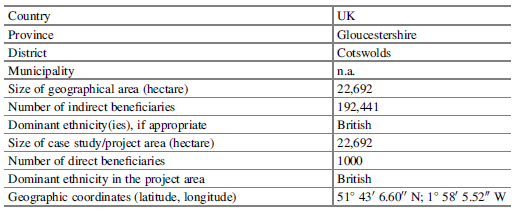
Table 9.2 Integrated local delivery model process (adapted from Short et al. 2010)
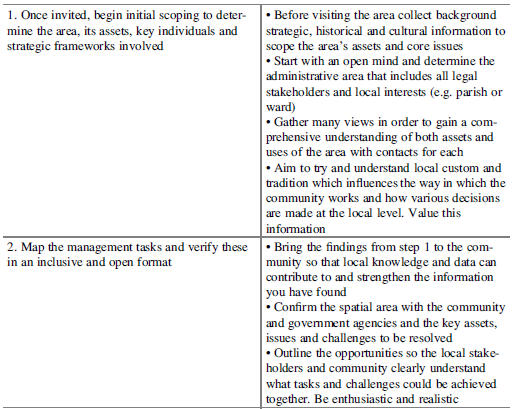
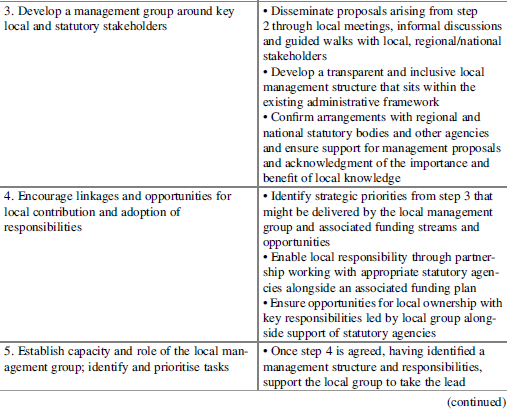
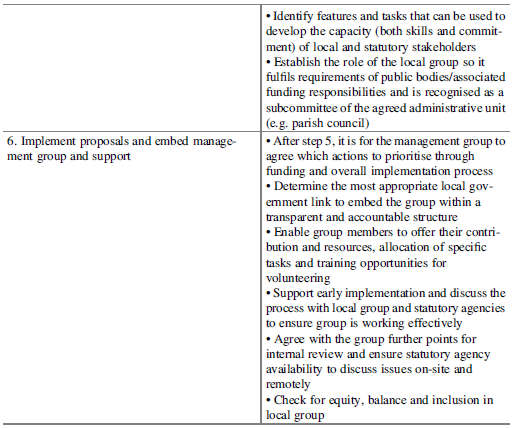

Fig. 9.3 Scoping phase within integrated local delivery (adapted from Short et al. 2010)
3.2 ILD Applicability to IPBES Transformative Governance Framework
Within the IPBES framework for transformative change, ‘levers’ and ‘leverage points’ highlight where and what interventions can be put in place to achieve mutually reinforcing, larger-scale changes towards more sustainable governance at multiple structural levels. The ILD approach allows these levers and leverage points to be identified in order for environmental management practices to be applicable to this global governance framework. A matching of these levers and leverage points with the WILD project has been undertaken.
3.3 ILD Evaluation: Survey and Interviews
The first stage of the WILD project (2013–2016) has been evaluated through the use of surveys and interviews (to gain a deeper understanding) across all stakeholder groups. In both year one (2013–2014) and year 3 (2015–2016) surveys and interviews were held with the community groups, farmers and partners involved. The results from the final year have been used for this paper, with the addition of any important notes on the initial 2013–2014 survey where relevant. Action research was undertaken through researchers attending group meetings and volunteer days to understand participants’ views. The evaluation intended to capture the process of interaction, level of equality in governance and outcomes between the various organisations, interest groups and communities through the wider and more integrated approach to water management. The evaluation framework also accounted for the ecological aspects (GES) of the project, undertaken by the EA.
4 Results
4.1 Overall Project Results
A total of 298 farm visits over 3 years were undertaken, with advice provided for 118 farms covering 22,692 ha of land. Of the 19 parishes in the catchment area, 16 engaged, as well as three towns, incorporating WILD into their Parish Planning. Further, 20 ‘farmer guardians’ were appointed over 10,000 ha who acted as key contacts liaising between the farming community and other stakeholders such as the EA and independent company Thames Water. Part of the project included reducing the amount of regulation from the EA and replacing this with a more collaborative approach, which empowered farmers to take their own action alongside support from other stakeholders. Local communities and members of the agencies involved contributed the equivalent of 216,000 GBP of volunteer time over 3 years. Com- munities discussed over 1500 issues regarding water flow, which were mapped and digitised. Management measures within the river were undertaken on 5580 m of river, tree pollarding and shade-reduction along 8555 m of river (Fig. 9.5), fencing along 5066 m of river, and five livestock drinking bays were installed (Fig. 9.4). “A Community Guide to Your Water Environment” was also produced and circulated nationally as a toolkit to Integrated Planning alongside the ILD.
Under the EU Water framework directive, the EA surveys the Ecological Status (ES—high, good, moderate, poor or bad) of the waterbodies every 3 years. ES is measured through the quality of multiple indicators including biological (e.g. phytoplankton, macroalgae, invertebrates, and fish), chemical and physicochemical, water (synthetic and non-synthetic pollutants) and hydromorphological. Following the first phase of the project, an improvement or lack of deterioration in the majority of waterbodies was measured. Both waterbodies initially deemed ‘bad’ improved to ‘moderate’ and two out of four initially deemed ‘poor’ improved to ‘moderate’, the other two remaining ‘poor’. Of those deemed ‘moderate’ initially, four out of six have remained so, whilst two have deteriorated to ‘poor’ or ‘bad’. It is important to note that the measurements taken to determine waterbody ES changed over the duration of the project, and therefore may have had an impact on these results. Depending upon when improvements to waterbodies were made, there may also be a lag in improvements (or otherwise) being seen, which would thus show in the next cycle of EA assessments. It is evident that there is still work to be done to improve and maintain some of the waterbodies up to GES through the ILD approach. Importantly, the evident deterioration of some waterbodies is due to poor agricultural practices such as livestock management, drainage and physical barriers to ecology.

Fig. 9.4 Soil erosion mitigation measure (drinking bay) for cattle when accessing the river (photo: Jenny Phelps)

Fig. 9.5 Better accessibility to waterbodies via the construction of a boardwalk for local commu- nities (photo: Jenny Phelps)

Fig. 9.6 Local community volunteers clearing riverside branches to improve water quality (photo: Jenny Phelps)

Fig. 9.7 Herbal leys sown by WILD farmers to enhance soil health (photo: Jenny Phelps)
4.2 Survey and Interview Results
4.2.1 WILD Partners
The partners surveyed included 15 respondents across eight organisations, of which a total of seven (47%) completed the final survey in 2015–2016. Most partner respondents felt that they had either a medium or high involvement with the WILD project and had a good understanding of the multiple objectives and aims of the project, as expected.
The respondent partners felt that the project’s main achievement, aside from progression towards GES, was strong social cohesion amongst all stakeholders involved. This included developing local networks, accountability and responsibility, tools and skills to improve resilience. The ILD management approach was thought to have been inclusive and information effectively shared amongst the stakeholders. In the first year, stakeholders voiced the need for better collaboration and dialogue across the project, however this had improved by the second and third years, with six out of seven partners expressing that, “the main project group collaborates and organises joint activities, fully integrating multiple areas of interest”. An important point regarding the reduction of farmer regulation to reduce the stress of breaching rules and nurture more environmentally respectful attitudes was voiced by one partner: “.. .there is no question that an approach which provides friendly advice is preferable to one which relies on enforcement, but both are required.” Regarding community involvement, partners reflected that despite it taking some time to work within local communities, they were able to see the benefits as the project progressed. One respondent remarked that “.. .it is the individuals involved in the delivery, as much as the delivery model itself, which is crucial to a partnership project’s success.” Key findings from the partners were that local communities matter and communication is vital. Further, integration of shared interests was thought to strengthen funding possibilities and promote project aim delivery.
4.2.2 Local Authorities and Councils
There was a total of six responses out of 32 potential respondents across five local authorities (19% response rate) to the final year survey (2015–2016). Most respondents (four out of six) stated high involvement with the project, with just one stating low involvement.
The respondent local authorities felt that the WILD project broadly focused on improving community relations, improving water quality and reducing flood risk (creating better ecosystem understanding). The collaborative approach was thought of as beneficial from the perspective of most respondents. However, the need for a greater amount of funding and a longer timeframe was voiced, as building relation- ships with communities takes time but, crucially, makes the project effective. The local authority respondents also had mixed views on whether the project had incorporated their views and interests; they did not always feel a strong relationship with the project. Despite this, they did think that community groups had equal opportunities to be involved. They further thought that good communication needed to be maintained through more feedback, and that the project lacked the relevant technical expertise for the ecological management of waterbodies. Regardless, the opinion was that the ILD should be used elsewhere across the country. It was thought to add value to the existing ‘conventional’ regulatory, institutionally-led (top-down) approach with fewer stakeholders. ILD’s implementation needs careful consideration of such previous approaches and resulting attitudes and relationships. One respondent commented, “ILD is working with people and that will always be preferred to enforcement through improved local involvement”.
4.2.3 Town Councils and Communities
A total of ten out of 19 parish and town councils responded (53%) to the final 2015–2016 survey. Only two out of ten respondents stated their involvement as low, two out of ten as high, and the remainder as medium.
For local communities, the main aims of the project were to improve knowledge and understanding of the water situation in the catchment and improve its quality and resilience to flooding. Most respondents felt that this had been achieved, whilst others perceived it as a continuous process. As the first stage of the project was short, there was not a perceived difference in the water quality by local communities. Despite this, they felt engaged and empowered to enact environmental management as WILD had provided crucial knowledge and support through key stakeholders who imparted this: “We are much better informed about surface water flow in the area, and this should enable us to decrease flood risk”. Community members now know who to contact if support is needed. Their awareness of the water environment has also increased, whilst activities such as mapping waterbodies and courses as well as clearing ditches were very valuable skills to learn. Key to this was the ability to create a work and maintenance plan, as well as involvement in neighbourhood plans for new building developments. Community members also felt able to undertake future work regarding the water environment, however concerns were expressed over funding and capacity. They felt that engagement with farmers had been both “constructive and effective”. The facilitation team was considered very valuable but had big time pressures which have the potential to affect future work through reducing enthusiasm and motivation.
4.2.4 Farmers and Land Owners
Across 100 farms there were five responses out of 22 potential respondents (23%) to the final 2015–2016 survey. A further ten farmers and land managers were interviewed face-to-face and views sought from a number of farmer-to-farmer meetings.
Over the course of the first 3 years, farmers and land owners felt that WILD had increased their knowledge and awareness of ecological management: “WILD has made us more aware of water movement and water management, so it has been positive”. Further, it has improved their awareness on sources of advice, volunteer labour and potential benefits to the community. Over the 3 years, farmers’ and land owners’ relationships to WILD improved, as more became involved and challenges decreased. Several respondents noted that the project was aiding their goals for national agri-environment schemes, which aim to encourage environmental land stewardship. It was therefore able to assimilate well with existing governance and policy mechanisms. Respondents voiced concerns over time costs, however these were mitigated by volunteers in undertaking management actions. The respondents acknowledged the beneficial capacity of volunteers. Despite this, there was some feeling of lower transparency, as volunteers “aren’t specialists”, with a clash in priorities: “.. .we need to monitor the environment, but emphasis is on increasing biodiversity, which conflicts with my view as an arable farmer”. However, WILD was seen as preferable to conventional national schemes due to its collaborative approach with reduced regulation, more flexibility and less administration. Farmers and land owners underwent behaviour change, embracing new techniques and approaches: “If there were an identical project to come along now, and knowing all the input I would have to do, I would still do it”.
5 Discussion
5.1 Change, Challenges and Opportunities of WILD
The main achievement of the WILD project has been to include all of the local and national interests in the discussion on priority water environment challenges, and to implement some measures within a 3-year period. There was no local resistance to the project, potentially due to the open and inclusive approach taken. Prior to this project, government schemes had fragmented management and very little multi- stakeholder discussion. This key difference highlights the importance of a qualified independent facilitator to inform, create networks, enable and crucially embed the process across multiple stakeholders and institutional levels. Most stakeholders involved felt engaged by the project and that its aims had either been achieved or were in progress. There was also an acknowledgement that this project involves long-term thinking and action, which needs time and support to build relationships, actions and reflections in order to evolve. In embedding the ILD approach across several localities, the facilitators have achieved a local self-governing system which is creating behaviour change in farmers, land owners, local community members as well as at institutional levels in local authorities, government bodies and organisations (Alexander 2006; IPBES 2019). However, there is still need from some stakeholders for facilitation, time and funding in order to progress the work which has begun. For those farmers and land owners who felt the process was less transparent than other schemes run by the government, there may still be progress to be made in communications between them and local communities. It will also be important for long-term monitoring of waterbodies and any ecological improvement to be presented and discussed by the WILD stakeholders in future years. Whilst funding for the following 3 years of the project (2016–2018) had been secured through a combination of the EA and private investment (Thames Water), beyond this funding, continuation is uncertain, especially in light of the UK separation from the EU. This funding has not extended to qualitatively evaluating the second stage of the project, therefore unfortunately the stakeholders’ perceptions and progress are yet unknown. The future uncertainty of the project needs to be addressed and a way found for multi-stakeholders to continue using an ILD approach to local and regional environmental issues.
5.2 ILD within IPBES Transformative Governance Framework
Table 9.3 shows how ILD fits within the IPBES governance and policy transformative change framework, identifying the levers and leverage points that were utilised during the WILD project. In fitting the ILD model to the IPBES framework, it is apparent that facilitation is a vital, underpinning factor to the cohesion of multi- stakeholders and the success of the project. In this context, the ILD and its facilitators build key ‘levers’, including capacity, cross-sectoral cooperation, decision-making processes and the ability for pre-emptive action in the future through networking and organisation of the project team. They also allow for awareness around environmental laws and making sure these are implemented by connecting communities to relevant institutions and their knowledge. The results above further show that the ILD model engages at ‘leverage points’ as wide stakeholder inclusion, striving for equality, respecting diverse values and building capacity and awareness around environmental issues is inherent to its process (IPBES 2019). Despite this, the results from participating stakeholders do show that this is a process that needs development with some groups, such as local authorities, needing greater engagement, and crucially facilitators needing more capacity to work with the project. Parallel to this is the need for funding which can create and strengthen capacities. Further, WILD has been able to undertake the IBPES iterative learning loop, as also demonstrated in Pahl-Wostl et al. (2008) study on social learning and culture in water management, through successive years of implementation, discussions, reflection and flexibility to evolve. Through its inherent process and iterative learning, WILD has begun the process of transformative change. It is apparent that WILD has directly incorporated global-level Sustainable Development Goals (SDGs) 2, 6, 9, 11 and 13 and Convention on Biodiversity targets 1, 3, 4, 7–9, 11, 14, 15, 18 and 19, which may help those implementing it to gain further international environmental recognition in conjunction with IPBES.
Table 9.3 WILD project levers and leverage points (summarised by J.E. Black) within the IPBES framework (IPBES 2019)
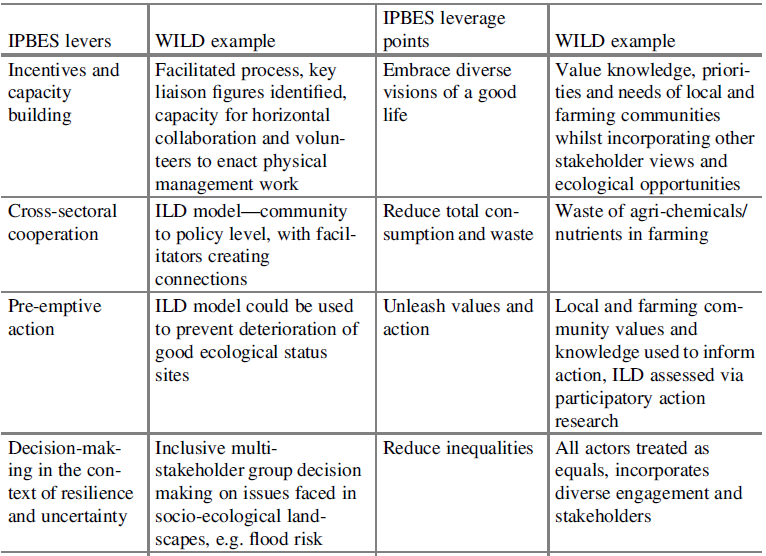
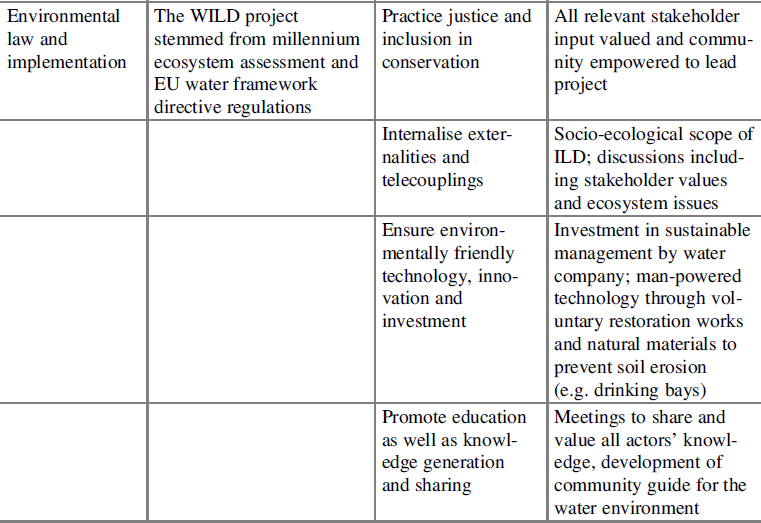
6 Conclusion
The WILD project has shown that the ILD model can be used to contribute to both national and international socio-ecological goals through an inclusive process. It has set in motion transformative change locally, but also further afield through the involvement of institutional partners. It deserves both more attention and scrutiny and should be part of the wider discussion on transformative change and alternative governance approaches. There are short-term needs in order to meet current, urgent agricultural and environmental challenges, but also longer-term issues that need to be explored through ILD, such as ensuring future motivation and discussing feed- back on environmental outcomes. The emphasis moving forward should be in delivering landscape-scale change and empowering communities to take ownership of this process.
Crucially, the model requires a trained facilitator with the trust of the local and agricultural communities, or key connectors within them, as well as time and funding in order to be successful. Therefore, long-term visions and resources need to be planned into ILD projects. This needs recognition from governments, who can also incentivise businesses to help garner funding. Demonstrating contribution to international frameworks such as IPBES, SDGs and CBD targets could help ILD projects to secure funding and influence further global uptake of the model.
Acknowledgements The WILD project was funded by the Environment Agency and its under- taking has been reliant on many individual volunteers, farmers, parish and town councils’ organisations and interest groups. Thanks are due to the main delivery partner, the Farming and Wildlife Advisory Group, and key delivery partners: Cotswold Water Park Trust, Gloucestershire Rural Community Council and Countryside & Community Research Institute and the National Farmers Union. Thanks finally to Thames Water who were an interested party in phase 1 of WILD, and provided funding in phase 2.
References
Alexander, E. R. (2006). Institutional design for sustainable development. Town Planning Review, 77(1), 2. https://doi.org/10.3828/tpr.77.1.2.
Blackstock, K. L., Waylen, K. A., Marshall, K. M., & Dunglinson, J. (2014). Hybridity of representation: Insights from River Basin management planning in Scotland. Environment and Planning C: Government and Policy, 32(3), 549–566. https://doi.org/10.1068/c11261.
Carlsson, L., & Berkes, F. (2005). Co-management: Concepts and methodological implications. Journal of Environmental Management, 75(1), 65–76. https://doi.org/10.1016/j.jenvman.2004. 11.008.
de Coninck, H., Revi, A., Babiker, M., Bertoldi, P., Buckeridge, M., Cartwright, A., et al. (2018).
Chapter 4: Strengthening and implementing the global response.
Gualini, E. (2018). Planning and the intelligence of institutions: Interactive approaches to territo- rial policy-making between institutional design and Institution-building. London: Routledge. https://doi.org/10.4324/9781315201726.
Healey, P. (1998). Collaborative planning in a stakeholder society. Town Planning Review, 1998, 1–21. https://doi.org/10.3828/tpr.69.1.h651u2327m86326p.
IPBES. (2019). Global assessment report on biodiversity and ecosystem service, debating nature’s value. https://doi.org/10.1007/978-3-319-99244-0_2.
Kozar, R., Galang, E., Alip, A., Sedhain, J., Subramanian, S., & Saito, O. (2019). Multi-level networks for sustainability solutions: The case of the International Partnership for the Satoyama Initiative. Current Opinion in Environmental Sustainability, 39, 123–134. https://doi.org/10. 1016/j.cosust.2019.09.002.
McAreavey, R. (2006). Getting close to the action: The micro-politics of rural development.
Sociologia Ruralis, 2006, 85–103. https://doi.org/10.1111/j.1467-9523.2006.00407.x.
MEA. (2005). Ecosystems and human well-being: Health synthesis. Washington, DC: Island Press. https://doi.org/10.1016/B978-0-12-809665-9.09206-5.
Natural England. (2015). National Character Area profile: 107. Cotswolds.
Ostrom, E. (2005). Understanding institutional diversity. Oxford: Princeton University Press.
Pahl-Wostl, C., Tàbara, D., Bouwen, R., Craps, M., Dewulf, A., Mostert, E., et al. (2008). The importance of social learning and culture for sustainable water management. Ecological Eco- nomics, 64(3), 484–495. https://doi.org/10.1016/j.ecolecon.2007.08.007.
Short, C. (2015). Micro-level crafting of institutions within integrated catchment management: Early lessons of adaptive governance from a catchment-based approach case study in England. Environmental Science and Policy, 53, 130–138. https://doi.org/10.1016/j.envsci.2015.06.009. Short, C., Griffiths, R., & Phelps, J. (2010). Inspiring and enabling local communities: An integrated delivery model for localism and the environment. Report to farming and wildlife advisory group and Natural England. Cheltenham: CCRI.
Tengö, M., Hill, R., Malmer, P., Raymond, C. M., Spierenburg, M., Danielsen, F., Elmqvist, T., & Folke, C. (2017). Weaving knowledge systems in IPBES, CBD and beyond—Lessons learned for sustainability. Current Opinion in Environmental Sustainability, 26–27, 17–25. https://doi. org/10.1016/j.cosust.2016.12.005.
Thiel, A., Mukhtarov, F., & Zikos, D. (2015). Crafting or designing? Science and politics for purposeful institutional change in social–ecological systems. Environmental Science & Policy, 53, 81–86. https://doi.org/10.1016/j.envsci.2015.07.018.
Note
The opinions expressed in this chapter are those of the author(s) and do not necessarily reflect the views of UNU-IAS, its Board of Directors, or the countries they represent.
Open Access This chapter is licenced under the terms of the Creative Commons Attribution 3.0 IGO Licence (https://creativecommons.org/licenses/by/3.0/igo/), which permits use, sharing, adaptation, distribution and reproduction in any medium or format, as long as you give appropriate credit to UNU-IAS, provide a link to the Creative Commons licence and indicate if changes were made.
The use of the UNU-IAS name and logo, shall be subject to a separate written licence agreement between UNU-IAS and the user and is not authorised as part of this CC BY 3.0 IGO licence. Note that the link provided above includes additional terms and conditions of the licence.
The images or other third party material in this chapter are included in the chapter’s Creative Commons licence, unless indicated otherwise in a credit line to the material. If material is not included in the chapter’s Creative Commons licence and your intended use is not permitted by statutory regulation, or exceeds the permitted use, you will need to obtain permission directly from the copyright holder.

